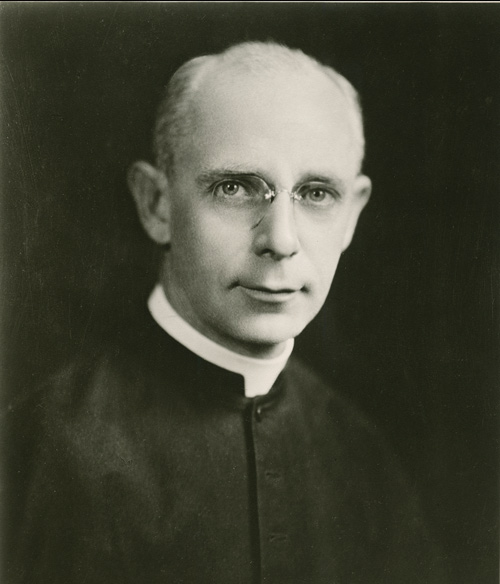A business school at Notre Dame
Author: Carol Elliott

Cardinal O’Hara
For Rev. John Francis O’Hara, C.S.C., a business school at Notre Dame was a necessary progression for the University — an acknowledgment that, even then, countries were becoming interconnected and that business could play a prominent role in shaping the future. O’Hara saw a great need for a school that was as focused on the students’ moral and ethical development as much as their business knowledge. And Notre Dame was the perfect place to provide this.
O’Hara had become inspired with this vision early on in his life when his father, John, was appointed by President Theodore Roosevelt as American consul to Uruguay. He was 17 when his family moved from Peru, Indiana, to Montevideo. After three years, his family moved to Indianapolis and O’Hara entered Notre Dame as a student in 1909, studying economics and political science. He would later attend the University of Pennsylvania’s Wharton School of Finance and Commerce.
According to O’Hara’s Heirs: Business Education at Notre Dame 1921-1991, O’Hara joined the Notre Dame faculty in 1916 as a “serious, devout and ambitious 28-year-old.” In this post-World War I period, Americans were coming to terms with what it meant to be involved in a global conflict and the ensuing impact on political, economic and civic perspectives going forward.
Historian Rev. Thomas T. McAvoy, C.S.C. wrote that O’Hara realized that Notre Dame could become “the northern terminus of a grand exchange of people and commerce between the two worlds of the Northern Hemisphere. His plans were large, and they fit well with the spirit of expansion that seemed to be dominant in Notre Dame as it approached its diamond jubilee celebration in 1917” (O’Hara’s Heirs, page 6).
If his plans were large, so was a particular obstacle: funding. O’Hara began energetic pursuits to raise the necessary endowments to establish the school, even offering an “honorary deanship” to a potential benefactor Ed Hurley, a well-respected Chicago businessman and public servant, before the College was even established.
Notre Dame was growing at the time, with plans to add medical and agricultural schools. While neither got off the ground, the University did undergo a major expansion from 1919 to 1933, adding 15 major building projects and instituting the graduate school. The student body tripled in size.
According to O’Hara’s Heirs: “In some ways, the University became a symbol of achievement for American Catholics coming of age in the United States. Notre Dame was increasingly perceived as the place where young Catholic men could receive the education necessary for them to enter the mainstream of the wider American culture. This often meant studies in business and commerce.”
The indefatigable O’Hara continued his cause by distributing pamphlets, giving public lectures and writing scholarly articles to promulgate the importance of global business and business education. He enhanced the University’s business course offerings and hired new faculty. Finally, on April 20, 1921, the University established the College of Foreign and Domestic Commerce and named Father O’Hara as the dean. It had an enrollment of nearly 400 students and 13 faculty members.
Although the College would grow rapidly, it was not without detractors who worried that business stressed the material over the spiritual, and provided vocational training rather than a true liberal arts education.
In addressing critics, O’Hara wrote an essay containing the now renowned words underlying Mendoza’s mission: “The primary function of commerce is service to mankind. Business has a code of ethics based very largely on divine principles. When this code is followed, commerce can and does advance civilization.”
O’Hara served as dean until 1924. He eventually would go on to be named as vice president of Notre Dame in 1933 and then president the following year. In 1939, he was appointed bishop of the military and titular bishop of Mylasa and served as a military chaplain during World War II. After the war, O’Hara was appointed bishop of Buffalo, New York, then archbishop of Philadelphia before being elevated to cardinal in 1958. He died at the age of 72 on Aug. 28, 1960.
Sources
Kerry Temple, O’Hara’s Heirs: Business Education at Notre Dame 1921-1991; University of Notre Dame, 1992.
Rev. Arthur J. Hope, C.S.C., Notre Dame: One Hundred Years. Notre Dame: University of Notre Dame Press, 1943.
Rev. Thomas T. McAvoy, C.S.C., Father O’Hara of Notre Dame. Notre Dame: University of Notre Dame Press, 1967.
